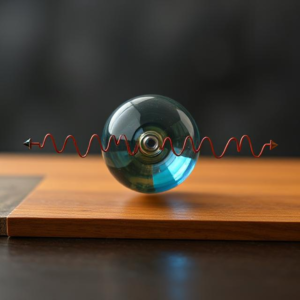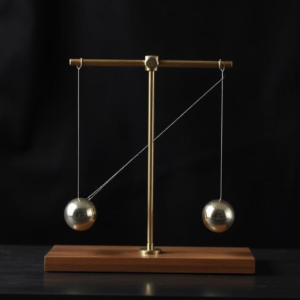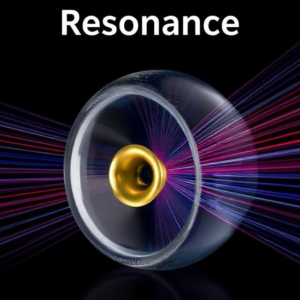1. What is Oscillation?
- What is it?
- Oscillation is the repetitive back-and-forth movement of an object around a central point or equilibrium position.
- It’s like when you swing back and forth on a swing. You go to one side, then return to the other side, and keep repeating this motion — that’s oscillation.
- Everyday Examples:
- A Pendulum: A pendulum in a clock moves back and forth — this is an oscillation.
- A Guitar String: When you pluck a guitar string, it moves back and forth (vibrates), which is another example of oscillation.
- A Spring: If you stretch a spring and then let it go, it will move back and forth around its equilibrium position, which is also oscillation.

2. What is Oscillatory Motion?
- What is it?
- Oscillatory motion is just a type of periodic motion — meaning the object moves in a regular pattern, repeating its movement over and over.
- Oscillatory motion happens when an object is displaced from its equilibrium (rest) position and then moves back toward it, and usually overshoots before returning. This motion repeats at regular intervals.
- Key Features of Oscillatory Motion:
- Equilibrium Position: The point where the object is at rest (i.e., no motion).
- Amplitude: The maximum displacement of the object from the equilibrium position (how far the object moves).
- Period: The time it takes for the object to complete one full oscillation (back and forth).
- Frequency: The number of complete oscillations that occur in a given time period (usually in seconds). The higher the frequency, the more oscillations per second.
- Example:
- A simple pendulum in a clock swings back and forth. The time it takes to go from one side to the other and return is its period, and the number of swings it makes in a minute is its frequency.
3. Types of Oscillatory Motion:
There are two main types of oscillatory motion:
1. Simple Harmonic Motion (SHM):
- What is it?
- Simple harmonic motion is a type of oscillatory motion where the restoring force (the force that brings the object back to its equilibrium position) is directly proportional to the displacement from the equilibrium position.
- This means the farther the object moves from the center, the stronger the force pushing it back.
- It’s like the swing on a playground: when you pull it farther away and let go, the force of gravity tries to pull it back, causing it to swing in a regular pattern.
- Formula for SHM:
Where:
is the restoring force.
is a constant related to the stiffness of the system (like the spring constant for a spring).
is the displacement from the equilibrium position.
- Example:
- A mass on a spring is a classic example of SHM. When you pull the mass and let it go, it oscillates back and forth, following a regular, predictable pattern.
2. Damped Oscillation:
- What is it?
- In damped oscillation, the motion gradually slows down and eventually stops due to friction or other forces that resist motion (like air resistance).
- For example, if you push a swing and let it go, the swing will eventually stop because of air resistance and friction at the pivot point.
- Example:
- A damped pendulum — where the pendulum slows down over time due to air resistance — is an example of damped oscillatory motion.
3. Driven Oscillation:
- What is it?
- In driven oscillation, an external force is applied to keep the system oscillating. This force is often applied at the system’s resonant frequency to keep it moving at a constant amplitude.
- Think of pushing a swing in just the right way, at just the right time, so it keeps going higher and higher — that’s driven oscillation.
- Example:
- A car’s shock absorber works by absorbing the energy from bumps on the road and oscillating to reduce the impact on the car.
4. Key Terms in Oscillatory Motion:
- Amplitude:
- The maximum distance the object moves from its equilibrium position. In simple terms, it’s how “big” the oscillation is.
- Frequency:
- How many complete oscillations (back and forth movements) occur in one second. The higher the frequency, the more times the object oscillates in a given time.
- Period:
- The time it takes for the object to complete one full oscillation (i.e., from one extreme to the other and back).
- Phase:
- Describes the position of an object within its cycle of oscillation at any point in time.
5. Real-life Examples of Oscillatory Motion:
- A Pendulum: A simple pendulum in a clock moves back and forth, showing oscillatory motion.
- Vibrating Guitar Strings: When a guitar string is plucked, it moves back and forth, creating sound. This is oscillatory motion.
- Tuning Forks: When struck, tuning forks vibrate in oscillatory motion and produce sound.
- Ocean Waves: The motion of waves in the ocean is also a form of oscillation, where water moves up and down.
Summary:
- Oscillation is simply the back-and-forth movement of an object around a central position.
- Oscillatory motion is periodic motion where the object moves in a regular, repeating pattern.
- Simple harmonic motion (SHM) is a special type of oscillation where the restoring force is proportional to the displacement.
- Damped oscillations gradually slow down due to forces like friction, and driven oscillations are sustained by an external force.











